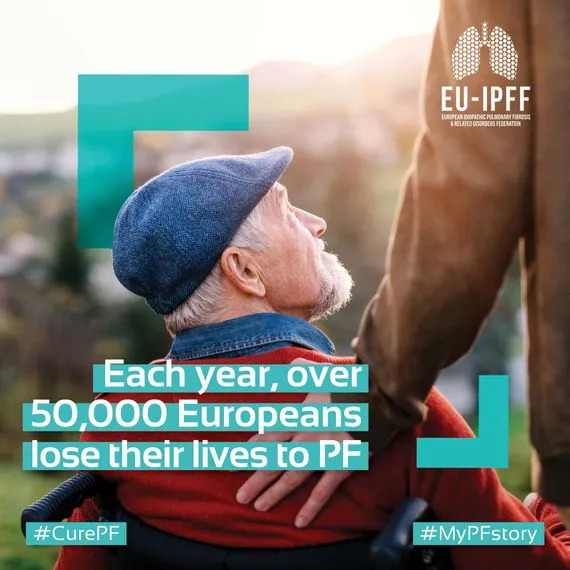About Pulmonary Fibrosis
Pulmonary Fibrosis (PF) is a progressive, irreversible, chronic lung disease causing scarring of the lung tissue with no known cure that typically occurs in people who are more than 45 years of age, with the average patient being 65 years old. In Europe, about 400,000 people live with Pulmonary Fibrosis and some 100,000 patients die each year from the disease. On average, PF patients die within 3–7 years after diagnosis.
The term Pulmonary Fibrosis – or Interstitial lung diseases (ILDs) – encompasses a large number of conditions, with a wide range of causes, clinical manifestations, and imaging and pathological features in the lung interstitium, as well as variable outcomes. The most common type of PF is IPF (Idiopathic Pulmonary Fibrosis), accounting for 200,000 patients in Europe.
Please find the most important information on the disease, its symptoms, diagnosis and treatment below. For more in-depth information, please see the EU-PFF Consultation Guides for both HCPs and patients here.

How does PF develop?
Despite the heterogeneity of this group of diseases, in most of them, damage to the cells that line the air sacs (or ‘alveoli’) of the lungs leads to the formation of scar tissue which is an essential response of the body against pathogens and in normal wound healing. This makes it harder for oxygen to pass into the bloodstream, and as a result, the brain, heart and other vital organs may not get the amount of oxygen they need to work properly. The amount of scarring usually increases over time, although how quickly it progresses varies.

What are the most common types of PF?
- Idiopathic Pulmonary Fibrosis
- Non-Specific Interstitial Pneumonia
- Chronic Hypersensitivity Pneumonitis
- Rheumatoid Arthritis – ILD*
- Scleroderma – ILD
- Fibrotic sarcoidosis
- Unclassifiable ILD

What are the symptoms of PF?
The symptoms of PF develop over time and can vary from person to person. At diagnosis, the most common symptoms of PF are shortness of breath, persistent dry cough and fatigue. Over time, the cough often becomes productive, and in the later stages of the disease, other factors such as loss of appetite, aching joints and muscles and gradual, unexplained weight loss can develop.
About half of PF patients may also experience finger clubbing – widening and rounding of the tips of the fingers or toes.
When someone uses a stethoscope to listen to the lungs of a person with PF, they may hear ‘velcro-like’ crackles in your lungs. These are ‘opening’ sounds which are made by the small airways when inhaling and can be heard in both lungs.

How is PF diagnosed?
Diagnosing PF is a process that encompasses several steps and investigations, starting with a CT scan of the lungs, but also lung function testing, bronchoalveolar lavage, blood tests or a biopsy. If a patient is suspected of having fILD, a multidisciplinary team to confirm diagnosis should at least include an expert pulmonologist, a radiologist, a pathologist and ideally a specialist nurse. Attendance of other disciplines, such as a rheumatologist, an occupational physician or a geneticist, may be of additional help.
Delayed diagnosis of PF is common and can occur at all stages. On average, it takes 7-8 months for a patient to receive a diagnosis, and in 40% of patients it takes more than a year. This may be due to symptoms of PF being similar to those of other, more common lung or heart diseases, and patients may be slow to consult their general practitioner (GP)/ primary care physician (PCP) once they show symptoms. Also, GPs/PCPs may not refer patients to pulmonary specialists quickly enough, and there can be delays in waiting for a hospital appointment and conducting the necessary tests to achieve a correct diagnosis. To avoid this delay, patients with suspected PF should be referred to ILD specialist centres.
In addition, 37% of patients are misdiagnosed at least once. If you don’t feel comfortable with your doctor or treated in the best possible way you might want to get a second opinion.

How is PF treated?
Decisions about pharmacological treatments depend on the diagnosis and the disease course. Antifibrotic drugs (Pirfenidone or Nintedanib) are recommended for pulmonary fibrosis, as they help to prevent tissue scarring and have been shown to slow progression of the disease over time and may increase life expectancy.
For some PF patients, immunomodulation (substances that affect the functioning of the immune system) is generally recommended as initial treatment. If the disease still progresses, antifibrotic therapy such as Nintedanib can be considered.
Besides those drugs, there are a number of non-pharmacological treatments that can enhance patients’ quality of life, such as pulmonary rehabilitation, oxygen therapy or lung transplantation.
Clinical Trials
Click here to learn more about clinical trials
What is a clinical trial? (see ClinicalTrials.gov for more information)
A clinical trial is a research study involving human volunteers (also called study participants) designed to advance medical knowledge. They are critical to accelerating the development of new treatments. There are two main types of clinical trials: clinical trials and observational studies.
In a clinical trial, participants receive medical interventions according to the study protocol. In clinical trials, a new medical treatment may be compared to an already available standard procedure, to a placebo that contains no active ingredients, or to no intervention. In some clinical trials, treatments that are already available are compared. When a new product or approach is investigated, it is usually not known whether it is helpful or harmful, or whether it is no different from available alternatives (including no intervention). A trial tries to determine the safety and effectiveness of the intervention by measuring specific outcomes in participants.
What are the benefits of a clinical trial?
- early access to a new treatment
- a more active role in your own health care
- medical care and more frequent health check-ups as part of your treatment
- helping others get a better treatment for their condition in the future
- access to information about peer support and other resources
What are the risks?
- The new treatment may cause serious side effects or be unpleasant
- The new treatment may not work or may not be better than treatments that already exist
- You may not be part of the treatment group (or experimental group) that receives the new treatment. You may instead be part of the control group, which means you receive the standard treatment or a placebo with no treatment
- The clinical trial may cause you inconvenience. For example, appointments may take a long time and/or you might have to travel to the trial center several times or stay in a hospital
With the intention to inform PF patients about ongoing clinical trials, the Federation has set up the so-called EU-PFF clinical trial finder: a search tool with which patients can filter for clinical trials that match their particular needs and specific type of disease. You can find it here.
Pulmonary Fibrosis and COVID-19
Click here to learn more about Pulmonary Fibrosis and COVID-19
COVID-19 is a new illness that can affect your lungs and airways. It is caused by a virus called coronavirus. Anyone can catch COVID-19 if they have been in contact with someone carrying the virus.
Patients at high risk from Covid-19 include
(i) people over 70 years of age
(ii) people with a pre-existing condition such as chronic respiratory disease, heart disease, diabetes or hypertension,
(ii) people on immunosuppression and some other medicines
All pulmonary fibrosis (PF) patients should consider themselves to be extremely vulnerable from coronavirus (COVID-19).
Guidance to avoid infection with COVID-19
EU-PFF with support of our Scientific Advisory Group has prepared the following guidance. It is based on information provided by Action for Pulmonary Fibrosis, UK with generous support of Galapagos and will help you avoid becoming infected with coronavirus.
If you are a pulmonary fibrosis patient self-isolating alone or with your partner
- You are strongly advised to stay at home at all times and avoid face-to-face contact with others. Home is the safest place for you. You can open a window or go into the garden but, if you do, keep a safe distance from neighbours
- Strictly avoid contact with anyone who is displaying symptoms of coronavirus (COVID-19). These symptoms include high temperature above 37.8 ºC and/or new and continuous cough
- Do not attend any gatherings. This includes gatherings of friends and families in private spaces such as family homes, weddings and religious services
- Do not go to your doctor’s surgery or to the hospital – all contact with heath care professionals should be by phone, internet or video conference
- Ask for deliveries of food or medications to be left at the door to minimise contact. Be vigilant and wipe anything coming into your home with disinfectant. The virus can live for three days on plastic or metal surfaces and one day on cardboard or paper
- Keep in touch with family and friends using the phone, internet and social mediaTips on self-isolation can be found here.
Note:
- Please read the official advice given in your country and consult information published by your national pulmonary fibrosis patient organisation (Please find links here). The period of time for which you will need to self-isolate will vary from country to country.
- Individuals who have less than six months to live or some others in special circumstances, may decide not to follow the advice.
If you live with other people who are not self-isolating
If you share your home with others, you will reduce your risk of catching COVID-19 if you:
- Keep 2 metres (3 steps) away from other family members, sleep on your own and use separate towels and a separate bathroom, if possible.
- Keep shared spaces such as kitchens, bathrooms and sitting areas well-ventilated and minimise as much as possible the time other family members spend in these areas.
- Clean any shared bathrooms every time they are used and try to use the kitchen at different times. Family cutlery and crockery should be washed well. Use a separate tea towel for the cutlery and crockery you use.
- Get everybody in the house to wash their hands frequently (20 secs with soap), avoid touching their faces and clean frequently touched surfaces.
If you are caring for somebody with pulmonary fibrosis
There are simple steps you can take to reduce the risk from COVID-19 for those you are caring for:
- Only provide care that is essential – do not make unnecessary visits or longer visits than necessary
- Wash your hands when you arrive and often during your visit, using soap and water for at least 20 seconds or use hand sanitiser.
- Cover your mouth and nose with a tissue or your sleeve (not your hands) when you cough or sneeze. Put used tissues in the bin immediately and wash your hands afterwards.
- Do not visit or provide care if you feel unwell – make alternative arrangements for their care instead.
- Provide information on who they should call if they feel unwell – how to access urgent medical advice or emergency services
- Look after your own well-being and physical health at all times
If you are self-isolating and you need help with food, medicines and essential supplies
It is important to seek help with the delivery of food, medicines and essential services and supplies, and for support with your physical and mental health and wellbeing.
Across Europe, governments, businesses, charities, and the general public are gearing up to help people who are extremely vulnerable to Covid-19 and have to stay at home. If you do not know who to contact, try your local council or pulmonary fibrosis patient organisation. You can also ask family, friends and neighbours to support you.
Your usual support from health and social care organisations should continue as normal. Your health or social care provider will be asked to take additional precautions to make sure that you are protected.
Steve Jones
EU-PFF President
13th April 2020
For more up to date information on COVID-19 and Pulmonary Fibrosis, please watch our webinar with Prof. Gisli Jenkins and this session from the Pulmonary Fibrosis Patient Summit 2022 with Dr Francesco Bonella.

